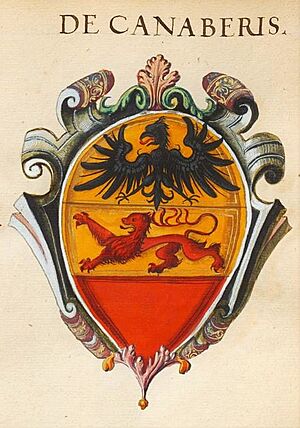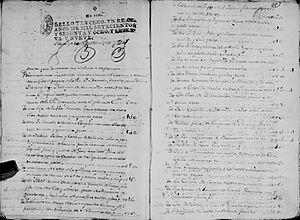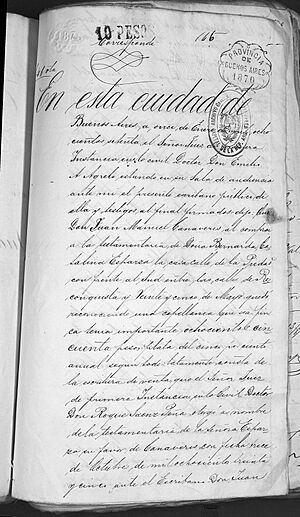Juan de Canaveris facts for kids
Quick facts for kids
Don
Juan de Canaveris
|
|
|---|---|
| Portero decano of the Tribunal Mayor de Cuentas de Buenos Aires | |
| In office 1777–1810 |
|
| Apoderado legal at the service of the Provinces of the Viceroyalty of the Río de la Plata | |
| In office 1772–1800 |
|
| Personal details | |
| Born |
Giovanni Antonio Domenico Jugluns de Canavery
1748 Saluzzo, Piedmont, Kingdom of Sardinia |
| Died | August 22, 1822 Buenos Aires, United Provinces of the River Plate |
| Resting place | Church of La Merced |
| Nationality | Italian |
| Political party | Bureaucrat - until 1810 Revolutionary |
| Spouse | Catalina Bernarda de Esparza |
| Relatives | Juan José Rocha y de la Torre (half-brother-in-law) |
| Occupation | government executor politician farmer |
| Profession | jurist accountant |
| Signature | |
| Military service | |
| Allegiance | |
| Years of service | 1806-1810 (Buenos Aires) |
| Battles/wars | British invasions of the Río de la Plata May Revolution |
Juan de Canaveris (also known as Canaverys) was an important lawyer and politician. He was born in 1748 in Piedmont, which is now part of Italy, and passed away in 1822. He lived in the Viceroyalty of the Río de la Plata, which was a Spanish colony in South America.
Juan de Canaveris worked as an accounting officer in the main accounting office in Buenos Aires. He became a respected member of society and strongly supported the May Revolution. This revolution led to Argentina's independence from Spain. He was the only person of Italian origin who attended the important meeting on May 22, 1810, where leaders discussed the future of the government.
He also played a big part in the first charity group in Buenos Aires, called the Hermandad de la Santa Caridad. Juan de Canaveris started a well-known family in Buenos Aires. His family later connected with many important families in Argentina and Uruguay. Many of his descendants became military leaders, lawyers, politicians, and priests.
Contents
Early Life and Career
Juan de Canaveris, whose full name was Giovanni Antonio Domenico de Canaveris, was born around 1748. His birthplace was Saluzzo, in what was then the Kingdom of Sardinia. He came to the Río de la Plata region around 1770. This was a time when Spain was making many changes to its colonies.
His first public record shows him working in 1772. He likely started his career in Buenos Aires in business. In 1776, he got a job as an "accounting officer" for the Royal Tribunal de Cuentas of Buenos Aires. This was a new government accounting office created by the Viceroy.
Juan de Canaveris worked in this accounting office for the entire time the Viceroyalty of the Río de la Plata existed. He was the oldest officer there. Even though his job title wasn't high, he earned a good salary, the same as a Senior Accountant. He was in charge of important paperwork and keeping the keys to the meeting room. Because of his good work, his salary was increased in 1799.
He also worked as a lawyer for important people and city councils. For example, he represented the City Council of Santiago del Estero. He helped them defend their local elections in 1796. He also represented Victorián de Villava, who was a protector of natural resources and Indigenous people in Bolivia. Juan de Canaveris helped him get permission to build windmills.
He also helped establish the Hospital de Caridad in Montevideo, Uruguay. In 1796, he was the legal representative for Francisco Antonio Maciel. He helped get approval to build this public hospital.
Juan de Canaveris was quite successful. He owned several homes, land, and valuable items. He also had business dealings with important people, including María Cristina Ross.
Role in the English Invasions and May Revolution

Juan de Canaveris and his family played a significant role during the English invasions of Buenos Aires. These invasions happened between 1806 and 1807. He and his colleagues at the accounting office refused to swear loyalty to the British leader. They also took part in secret meetings organized by the city's residents to plan resistance.
He helped by donating money to the city's defense efforts. His sons also joined different military groups to defend Buenos Aires. For example, his son Mariano was a second lieutenant in the Hussars regiment. A relative of his wife, Friar Martin Esparza, was killed by British troops during the second invasion.
Juan de Canaveris is remembered for attending the important meeting on May 22, 1810. This meeting, called an "open Cabildo," was a key event in the May Revolution. He was part of a group that wanted the local city council (Cabildo) to take over the government. They believed this temporary government should rule until the Spanish king could return to power. He supported the idea of removing the Viceroy, Baltasar Hidalgo de Cisneros. His wife was also related to Antonio Beruti and Domingo French, who were leaders of the revolution.
Like many wealthy people of his time, he also bought land and managed farms. He owned a farm in Quilmes and another in San Isidro. This farm was near the properties of Juan Martín de Pueyrredón and Miguel de Azcuénaga, who were friends of his family.
Family Life
Juan Canaveris married Catalina Bernarda de Esparza, who came from a noble family. Their wedding took place on May 4, 1772, at the Cathedral of Buenos Aires.
They lived in the San Nicolás neighborhood of Buenos Aires and had twelve children: six boys and six girls. Their children were born between 1773 and 1797. Their house was located on Calle de la Piedad, near the Fonda de los Tres Reyes, which was a major inn in the early 1800s.
Juan and his wife were very religious Catholics. They belonged to the Order of the Blessed Virgin Mary of Mercy. Two of their daughters, María Antonia and Dominga, joined a religious order.
Their grandchildren included Sinforoso Amoedo, a doctor who died during the yellow fever epidemic of 1871, and Ángel Canaveris, a respected psychiatrist. The family was also connected to Domingo Matheu, a member of the first governing body of Argentina.
Juan de Canaveris passed away on August 22, 1822, and was buried in the Church of La Merced. His wife, Bernarda Catalina de Esparza, died several years later in 1832.
His family name is connected to many other important families in Argentina. Through his daughter María Eugenia Canaveris, his family is linked to General Justo José de Urquiza. Urquiza was a president of the Argentine Confederation.
Legacy and Influence
Juan de Canaveris used many different spellings for his last name, such as Canavero, Canavé, and Canavery. The name Canaveris comes from a place name, common in Northern Italy and France.
His family played a part in the early days of education in Argentina. They were among the first to use the Lancasterian teaching system. Some of his descendants were also involved in building railways in Buenos Aires. This included the Buenos Aires Great Southern Railway and the Lacroze Railroad.
General Enrique Mosconi, a great-grandson of Juan Canaveris, became president of YPF, a major oil company in Argentina. His father helped build the Central Argentine Railway.
Juan de Canaveris's descendants participated in many important political and military events in Argentina and Uruguay. They joined major political parties of the time. They also helped establish important economic institutions in Argentina. These included the Bank of the Province of Buenos Aires and the Buenos Aires Stock Exchange.
Members of his family also helped settle new areas like La Pampa and Patagonia. For example, Samuel Canaveris was the Mayor of Río Gallegos several times.
Pedro Canaveri and Zoilo Canavery, who were great-great-grandchildren of Juan Canaveris, were pioneers in Argentine soccer. Another family member, Carlos M. Canaveris, helped start the Club Atlético y Tiro Federal in 1907.
The houses owned by the Canaveris Esparza family were rented to immigrants from England, France, and Ireland. Later, his grandsons lived in these houses. Some of these properties were sold to important figures like Nicolás Hugo de Anchorena.
Juan Canaveris also owned land in what is now La Lucila. This land was later sold by his son Joaquín Canaveris.
Juan de Canaveris never made a will. His last record shows him claiming his wife's rights in a family inheritance case. His wife, Bernarda Catalina de Esparza, passed away in 1832 and had a special funeral.
See also
 In Spanish: Juan de Canaveris para niños
In Spanish: Juan de Canaveris para niños







